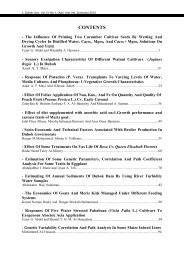Create successful ePaper yourself
Turn your PDF publications into a flip-book with our unique Google optimized e-Paper software.
J. Duhok Univ., Vol.14, No.1 (Pure and Eng. Sciences), Pp 25-29, 2011<br />
EXISTENCE AND UNIQUENESS SOLUTION FOR NONLINEAR<br />
VOLTERRA INTEGRAL EQUATION<br />
RAAD. N. BUTRIS * and AVA SH. RAFEEQ **<br />
* Dept. of Mathematics, Faculty of Education, University of Zakho ,Kurdistan Region-Iraq<br />
** Dept. of Mathematics, Faculty of Science, University of Duhok ,Kurdistan Region-Iraq<br />
(Received: February 14, 2010; Accepted for publication: November 28, 2010)<br />
ABSTRACT<br />
In this paper, we study the existence and uniqueness solution for nonlinear Volterra integral equation, by using<br />
both methods ( Picard Approximation ) and (Banach Fixed Point Theorem). Also these methods could be developed<br />
and extended throughout the study.<br />
KEYWORDS: Existence and Uniqueness Solution; Volterra Integral Equation; Non-linear; Picard Approximation; Banach<br />
Fixed Point Theorem.<br />
I<br />
INTRODUCTION<br />
ntegral equations are encountered in<br />
various fields of science and numerous<br />
applications (oscillation theory, fluid dynamics,<br />
electrical engineering, etc.).<br />
Exact (closed-form) solutions of integral<br />
equations play an important role in the proper<br />
understanding of qualitative features of many<br />
phenomena and processes in various areas of<br />
natural science. Lots of equations of physics,<br />
chemistry and biology contain functions or<br />
parameters which are obtained from experiments<br />
and hence are not strictly fixed. Therefore, it is<br />
expedient to choose the structure of these<br />
functions so that it would be easier to analyze<br />
and solve the equation. As a possible selection<br />
criterion, one may adopt the requirement that the<br />
model integral equation admit a solution in a<br />
closed form. Exact solutions can be used to<br />
verify the consistency and estimate errors of<br />
various numerical, asymptotic, and approximate<br />
methods. Recently, [2,3,6].<br />
Pachpztte [5] studied the global existence of<br />
solutions of some volterra integral and integrodifferential<br />
equations of the form<br />
t<br />
x ( t ) �h( t ) ��k(<br />
t , s ) g ( s, x ( s )) ds ,<br />
and<br />
0<br />
t<br />
'<br />
x t f t x t k t s g s x s ds<br />
( ) � ( , ( ), � ( , ) ( , ( )) ),<br />
0<br />
with initial condition x(0) � x . o<br />
Tidke [7] investigated the existence of global<br />
solutions to first-order initial-value problems,<br />
with non-local condition for nonlinear mixed<br />
Volterra-Fredholm integro differential equations<br />
in Banach spaces of the form.<br />
t b<br />
'<br />
x () t f ( t , x ( t ), k ( t , s, x ( s)) ds, h( t , s, x ( s)) ds )<br />
0 0<br />
� � �<br />
with non-local condition<br />
x (0) �g( x ) � x . o<br />
Consider the following non linear system of<br />
Volterra integral equations which has the form :<br />
t s<br />
( , ) ( ) ( , ( , ), ( , �) ( �, ( �, )) �,<br />
o o<br />
a<br />
o<br />
��<br />
o<br />
x t x F t f s x s x G s g x x d<br />
� �� �<br />
�<br />
b( s)<br />
as ( )<br />
g ( �, x ( �, x )) d� ) ds,<br />
o<br />
(1)<br />
where x D<br />
n<br />
R<br />
n<br />
domain subset of Euclidean space R .<br />
Let the vectors functions<br />
f ( t , x , y , z ) � ( f ( t , x , y , z ), f ( t , x , y , z ),..., f ( t , x , y , z ))<br />
� � D is a closed and bounded<br />
1 2<br />
g ( t , x ) � ( g1( t , x ), g2( t , x ),..., g n ( t , x ))<br />
and<br />
Fo ( t ) � ( Fo1( t ), Fo2( t ),..., Fon ( t ))<br />
are defined and continuous in the domain<br />
( t , x , y , z ) �[ a, b] �D �D1 �D 2 � ( ��, � ) �D �D1 �D<br />
(2)<br />
2<br />
where 1 D and D 2 are closed and bounded<br />
m<br />
domains subsets of Euclidean space R .<br />
Suppose that the functions f ( t , x , y , z ) and<br />
g ( t , x ) satisfy the following inequalities :<br />
f ( t , x , y , z ) �M, g ( t , x ) � N<br />
(3)<br />
f ( t , x , y , z ) �f( t , x , y , z ) �Kx�x�Ly� y<br />
1 1 1 2 2 2 1 2 1 2<br />
�Qz1� z 2<br />
(4)<br />
g ( t , x ) �g( t , x ) �Hx� x<br />
(5)<br />
1 2 1 2<br />
for all t �[ a, b] , x , x 1, x 2 �D , y , y 1, y 2 � D1<br />
,<br />
z , z 1, z 2 � D2<br />
.<br />
where M and N are positive constant vectors<br />
and K , L , Q and H are positive constant<br />
matrices. Let G(t , s) is an (n � n) positive<br />
matrix which is defined and continuous in the<br />
n<br />
25



